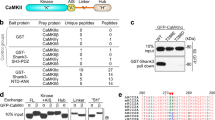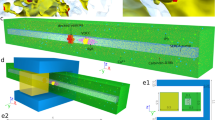Abstract
Using targeted mouse mutants and pharmacologic inhibition of αCaMKII, we demonstrate that the αCaMKII protein, but not its activation, autophosphorylation or its ability to phosphorylate synapsin I, is required for normal short-term presynaptic plasticity. Furthermore, αCaMKII regulates the number of docked vesicles independent of its ability to be activated. These results indicate that αCaMKII has a nonenzymatic role in short-term presynaptic plasticity at hippocampal CA3-CA1 synapses.
This is a preview of subscription content, access via your institution
Access options
Subscribe to this journal
Receive 12 print issues and online access
$209.00 per year
only $17.42 per issue
Buy this article
- Purchase on Springer Link
- Instant access to full article PDF
Prices may be subject to local taxes which are calculated during checkout



Similar content being viewed by others
References
Bennett, M.K., Erondu, N.E. & Kennedy, M.B. J. Biol. Chem. 258, 12735–12744 (1983).
Benfenati, F. et al. Nature 359, 417–420 (1992).
Erondu, N.E. & Kennedy, M.B. J. Neurosci. 5, 3270–3277 (1985).
Chapman, P.F., Frenguelli, B.G., Smith, A., Chen, C.M. & Silva, A.J. Neuron 14, 591–597 (1995).
Hinds, H.L., Goussakov, I., Nakazawa, K., Tonegawa, S. & Bolshakov, V.Y. Proc. Natl. Acad. Sci. USA 100, 4275–4280 (2003).
Giese, K.P., Fedorov, N.B., Filipkowski, R.K. & Silva, A.J. Science 279, 870–873 (1998).
Elgersma, Y. et al. Neuron 36, 493–505 (2002).
Elgersma, Y., Sweatt, J.D. & Giese, K.P. J. Neurosci. 24, 8410–8415 (2004).
Silva, A.J., Stevens, C.F., Tonegawa, S. & Wang, Y. Science 257, 201–206 (1992).
Zucker, R.S. & Regehr, W.G. Annu. Rev. Physiol. 64, 355–405 (2002).
Sumi, M. et al. Biochem. Biophys. Res. Commun. 181, 968–975 (1991).
Ishida, A., Kameshita, I., Okuno, S., Kitani, T. & Fujisawa, H. Biochem. Biophys. Res. Commun. 212, 806–812 (1995).
Schikorski, T. & Stevens, C.F. Nat. Neurosci. 4, 391–395 (2001).
Tyler, W.J. & Pozzo-Miller, L.D. J. Neurosci. 21, 4249–4258 (2001).
Borst, J.G. & Sakmann, B. Nature 383, 431–434 (1996).
Acknowledgements
We greatly appreciate the help of H. Beck, M. Merkens, R. Anwyl, K. Wang and R. Colbran for their (hands-on) advice on the use of CaMKII inhibitors, and from G. Borst and S. Kushner and members of the Silva and Elgersma lab for stimulating discussions and critically reading the manuscript. We thank M. Elgersma, H. van der Burg and E. Phillips for technical support. This work was supported by grants from NWO-ZonMW (TOP, VIDI) and Neuro-BSIK to Y.E. We also thank the University of Alabama, Birmingham Neuroscience Cores (P30-NS47466, P30-HD38985, P30-NS57098).
Author information
Authors and Affiliations
Corresponding author
Ethics declarations
Competing interests
The authors declare no competing financial interests.
Supplementary information
Supplementary Text and Figures
Supplementary Figures 1–4, Methods (PDF 1543 kb)
Rights and permissions
About this article
Cite this article
Hojjati, M., van Woerden, G., Tyler, W. et al. Kinase activity is not required for αCaMKII-dependent presynaptic plasticity at CA3-CA1 synapses. Nat Neurosci 10, 1125–1127 (2007). https://doi.org/10.1038/nn1946
Received:
Accepted:
Published:
Issue Date:
DOI: https://doi.org/10.1038/nn1946
This article is cited by
-
In Vivo Amphetamine Action is Contingent on αCaMKII
Neuropsychopharmacology (2014)
-
Mechanisms of CaMKII action in long-term potentiation
Nature Reviews Neuroscience (2012)
-
Properties of Contextual Memory Formed in the Absence of αCaMKII Autophosphorylation
Molecular Brain (2011)
-
Regulation of Synaptic Transmission by Presynaptic CaMKII and BK Channels
Molecular Neurobiology (2008)



